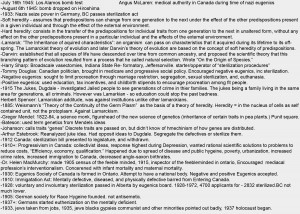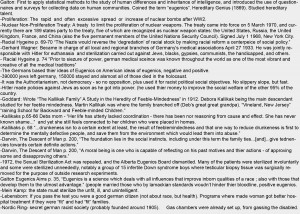This was for a human geography course – but I’m having a problem figuring out why the course isn’t classified as history. I could write on whatever I wanted within the context of British Columbia from 1500 – 1945, so I picked what I knew about. (Got it back on December 2nd, 2011 – got an “A” – YAY!)
Transformation of the Space-Time Gap of Technology and Communications In British Columbia, 1500 – 1945
With the arrival of colonial powers to the land imaginarily bordered and now called British Columbia, a change in human interaction caused a shift in the understanding of the spatial characteristics of human geography to regions that Indigenous peoples once bordered themselves. While the spatial characteristics of human relations became continuously more compressed for colonial immigrants when they settled in British Columbia in the early nineteenth century, for those Indigenous peoples whose families had lived and traded in the region for thousands of years, the opposite was true. This discrepancy is due to the new technologies perpetually introduced from Britain to the colonial populace of British Columbia, who were generally of British or Chinese descent (UBC Geography 121 lecture, September 26, 2011). Meanwhile, the Indigenous peoples of multiple bands, many with unique languages, endured discrimination and exploitation including the obstruction of language, economic prosperity, subsistence technologies, and trade. This essay will further discuss the disparity of the spatial character of human interactions between the colonists and the Indigenous peoples of British Columbia during post-colonial settlement of the land from 1500 until the year 1945. When British Imperialist colonists stormed the prosperous economies and already compressing space-time gap of the Indigenous peoples of British Columbia, it was Western ideas and communication technologies that expanded this compression and then compressed it a different way than it had been before in the duration of three hundred years.
Before British colonists settled in Fort Langley in 1827 and later on Vancouver Island in 1843, Indigenous bands living along the Coast of North America and further inland had long trading routes, based on broad family connections remembered in oral tradition from hundreds of years in the past (Francis, Jones, and Smith, 2009, p. 420). Many bands who fished for their food knew how to canoe British Columbia’s rivers and knew their currents so well that they could visit their tenth cousin in sq̓əw̓nəc in the morning and be back in xʷməθkʷəy̓əm by nightfall (Shaw and Campbell, 1998-2011, p. 9). This large, highly accessible social network of kinship groupings made it easy for the Indigenous peoples of British Columbia to associate with each other and as more people became relatives with each other, often by marriage, and the currents flowing along the coast of British Columbia were full memorized, the space-time compression of Indigenous travel and communication grew increasingly tighter. Potlatches encouraged this process of space-time compression through the spreading wealth and resources as well as the spreading of culture and language (Francis et al, 2009, p. 421).
When colonists decided to settle in West Coast regions of British Columbia at the discretion of the British Monarchy and the Hudson’s Bay Company, they saw Potlatch Ceremonies and banned them within the next century (Francis et al, 2009, p. 421). This was because of how much wealth was passed around from band to band. Jesuits especially thought that this was suspicious and came to the conclusion that the Potlatch must have been against Christianity is some way. To block traditional knowledge of trade, kinship connections, and subsistence technologies, and to re-acculturate British Columbia’s Indigenous peoples into Christian ideals, residential schools were built in the late nineteenth century. Indigenous children were forced to move away from their families and their culture beginning the process of time-space decompression. Most traditional Indigenous knowledge of British Columbia failed to be passed down orally during this time, and between this time and 1945, the British claimed Indigenous people’s land without making treaties, leading those who exited the residential school system to not have any culture or subsistence practices to rely on except for what the Hudson’s Bay company and the later what the Canadian federal Government gave them (Regan, 2010, p. 88). This unfortunate series of events for the Indigenous population of British Columbia caused the space-time compression of communications to expand in communities left with little tradition in 1945. People no longer knew their tenth cousin in sq̓əw̓nəc anymore, as it was an odd practice to keep such a large family in colonial thought. Likewise it would take them days to get to his house and back down the Fraser River due to the fact that they could not navigate the system of currents due to the lack of transmission of traditional knowledge.
While this devastation was suffered to the Indigenous peoples of British Columbia, significant space-time compression occurred for the Colonial population of British Columbia, especially as electricity was brought to British Columbia, and new communication like telephones and transportation technologies like steam engines and later automobiles became standard in most non-indigenous populaces (UBC Geography 121 Lecture, September 26, 2011). It should be noted that due to the lack of economic prosperity that the Indigenous peoples of British Columbia were forced to undergo, they often could not afford such technologies. When colonial settlers established electricity and later telephone wires in the very late nineteen century and early 20th century, twenty years after Britain had done the same, the time-space compression between colonial British Columbians making laws, transmitting information, and hearing ‘news’ was tremendous compared to what it had been before (Francis, Jones, and Smith, 2008, p. 114). In 1893 the Aboriginal Judicial System on the mainland of British Columbia could communicate to judicial systems not meant for Indigenous peoples as to confirm information and to settle claims and cases as easily as possible (BC Reports – 01, 1867). Likewise, consumer goods were moved faster than ever before with the construction of roads, and later railways. Information began to travel faster, and efficient means of transportation and communication became a commodity (Geography 121 Lecture. September 26, 2011).
What British colonists did not count on with all of this newly invented transportation and communication technology is that it would trigger British Columbia’s Indigenous peoples to begin changing their identity into a united group of peoples with similar beliefs and wants. British Columbia’s Indigenous peoples, although still very protective of their band-names and what was left of their languages, grouped into what is called a Pan-Indigenous population, creating more communication between different bands than ever before, usually in the common language of English. The establishment of English as a Universal language in Indigenous communities resulted in a space-time compression because there no longer had to be interpreters among groups as their had once been during Potlatches. A result of this Pan-Indigenous consciousness was the Allied Indian Tribes of British Columbia, a group who fought for Indigenous land from 1887 until 1927 when it unfortunately disbanded (Foster, 1999, p. 27). The Pan-Indigenous view lived on after the Allied Indian Tribes of British Columbia and British Columbia’s Indigenous peoples fought for fishing and hunting rights, with increasing intensity as new technologies like radio and to a lesser extent television began to show the colonial view of Indigenous peoples as a whole (Sardar and Loon, 2000, p. 76).
By the early twentieth century British Columbia’s lumber, fish, coal, and agricultural commodities began to be transported around the province by train expeditiously on the newly built Pacific Great Eastern Railway, which admittedly was not complete constructed until post 1945, but was still semi-functional (Wedley, 1998, p. 29). With all of the consumer goods brought into homes of ignorant multigenerational settlers, British Columbia’s social spatial changes began to influence its economic spatial changes. Supply and demand could be based on physical demands by phone or by commercials on the radio, and equally by how people’s outlook had been changed by technology (Sardar and Loon, 2000,p. 25). In the thirty years leading up to 1945, Indigenous peoples of British Columbia were also influenced by these technologies – even if the commercials were not aimed at them. Like the settlers of British Columbia, the Province’s Indigenous peoples wanted vacuums, electric stoves, and irons, but now a different kind of discrimination was upon them inflicted by new communication technologies that were supposed to help bridge the gap between communications. Instead of making a “middle-ground” between British Columbia’s settler population, which by now had forgotten its settler status, and its Indigenous population, the Indigenous peoples of British Columbia became increasingly marginalized by the stereotypes which space-time gap compressing technologies had created (UBC History 302 Lecture, October 18, 2011). Without those technologies, the transmission of a single degrading “Indian” identity could not be created and reinforced (Sardar and Loon, 2000, p. 135).
In the 1500’s until the mid-1900’s, colonial powers had a slow, but steady revolution in communications technology that had the capacity to change human interactions and caused a shift in the understanding of the spatial characteristics of human geography to regions of British Columbia that Indigenous peoples once governed. Eventually Indigenous peoples of British Columbia, and the rest of North America became an unfortunate marginalized stereotype to settlers, reinforced by movies about “Cowboys and Indians” and “The Indian Princess.” The setter population of British Columbia did not acknowledge the stereotypes that the compression of the space-time gap in communication caused, 1945 was not the last year that the Canada’s Indigenous peoples would endure the consequences of the change in spatial thought. With the loss of ownership of resources and continuous de-culturation of Indigenous peoples through the residential school system, British Columbia’s Indigenous peoples had no choice but to partake in the shift of spatial thought through technology, even when they often had to struggle to do so. This shift was an exertion in which Indigenous peoples would feel remorse for generations to come.




